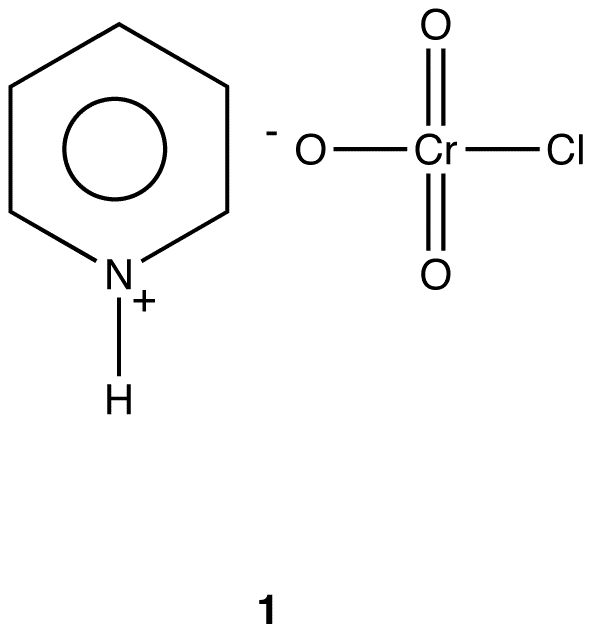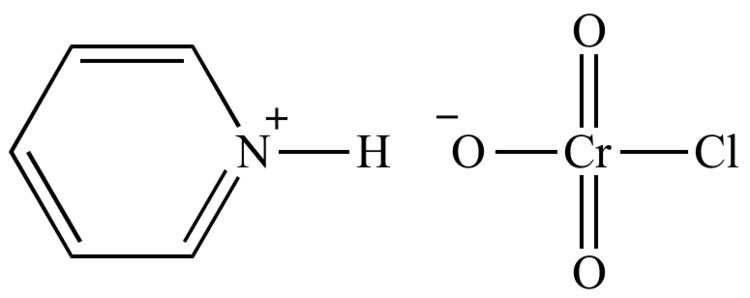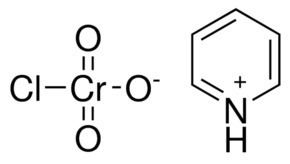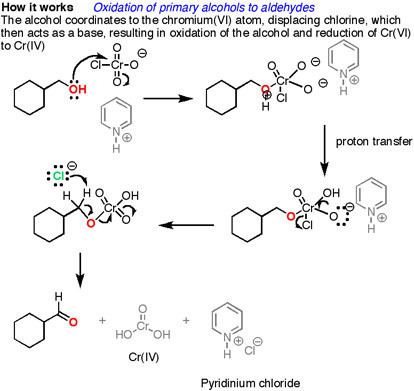Formula C5H5NHClCrO3 Appearance yellow-orange solid | Molar mass 215.56 g/mol | |
 | ||
Pyridinium chlorochromate (PCC) is a yellow-orange salt with the formula [C5H5NH][CrO3Cl]. It is a reagent in organic synthesis used primarily for oxidation of alcohols to form carbonyls. A variety of related compounds are known with similar reactivity. Although no longer widely used, PCC offers the advantage of the selective oxidation of alcohols to aldehydes or ketones, whereas many other reagents are less selective.
Contents

Structure and preparation

PCC consists of a pyridinium cation, [C5H5NH]+, and a tetrahedral chlorochromate anion, [CrO3Cl]−. Related salts are also known, such as 1-butylpyridinium chlorochromate, [C5H5N(C4H9)][CrO3Cl].

PCC is commercially available. Discovered by accident, the reagent was originally prepared via addition of pyridine into a cold solution of chromium trioxide in concentrated hydrochloric acid:
C5H5N + HCl + CrO3 → [C5H5NH][CrO3Cl]
In one alternative method, formation of chromyl chloride (CrO2Cl2) fume during the making of the aforementioned solution was minimized by simply changing the order of addition: a cold solution of pyridine in concentrated hydrochloric acid was added to solid chromium trioxide under stirring.
Oxidation of alcohols

PCC is used as an oxidant. In particular, it has proven to be highly effective in oxidizing primary and secondary alcohols to aldehydes and ketones, respectively. Unlike with the related Jones reagent, rarely does over-oxidation occur to form carboxylic acids, whether intentionally or accidentally. A typical PCC oxidation involves addition of an alcohol to a suspension of PCC in dichloromethane. The general reaction is:
2 [C5H5NH][CrO3Cl] + 3 R2CHOH → 2 [C5H5NH]Cl + Cr2O3 + 3 R2C=O + 3 H2OFor example, triterpene lupeol was oxidized to lupenone:
Other reactions

With tertiary alcohols, the chromate ester formed from PCC can isomerize via a [3,3]-sigmatropic reaction, the Babler oxidation. Other common oxidants usually lead to dehydration because such alcohols cannot be oxidized directly.
PCC also converts suitable unsaturated alcohols and aldehydes to cyclohexenones. This pathway, an oxidative cationic cyclization, is illustrated by the conversion of (−)-citronellol to (−)-pulegone. PCC also effects allylic oxidations, for example, in conversion of dihydrofurans to furanones.
Related reagents
Other more convenient or less toxic reagents for oxidizing alcohols include dimethyl sulfoxide, which is used in Swern and Pfitzner–Moffatt oxidations, and hypervalent iodine compounds, such as the Dess–Martin periodinane.
Safety
One disadvantage to the use of PCC is its toxicity, which it shares with other hexavalent chromium compounds.
